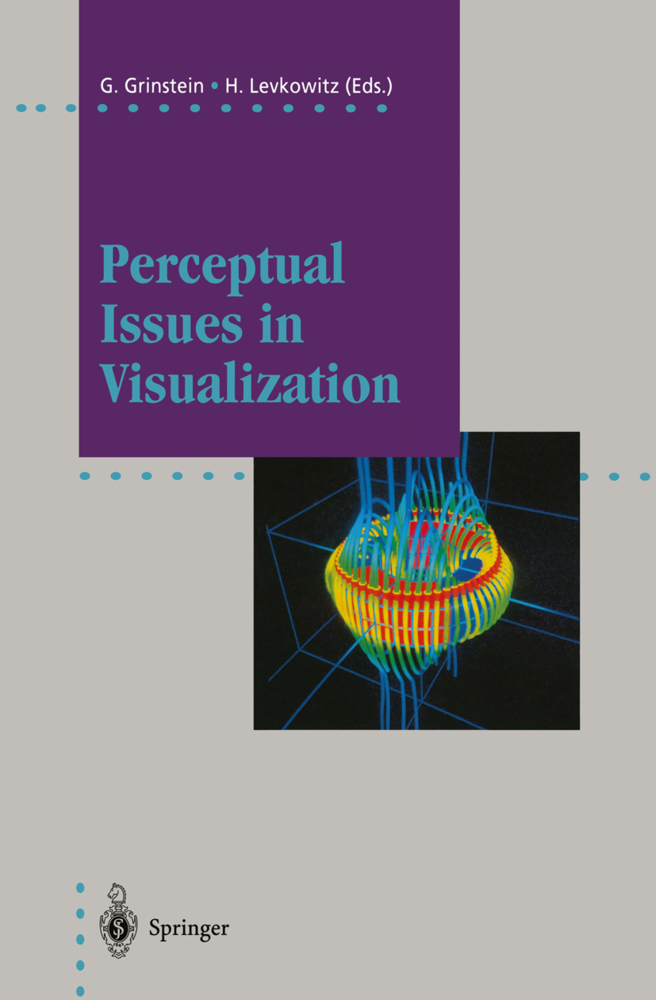Perceptual Issues in Visualization
Perceptual Issues in Visualization
With the increase in the amount and dimensionality of scientific data collected, new approaches to the design of displays of such data have become essential. The designers of visual and auditory displays of scientific data seek to harness perceptual processes for data exploration. The general aim is to provide ways for raw data, and the statistical and mathematical structures they comprise, to "speak for themselves" and, thereby, enable scientists to conduct exploratory, in addition to confirmatory analyses of their data. The present primary approach via visualization depends mainly on coding data as positions of visually distinguishable elements in a two- or three- dimen sional euclidean space, e.g., as discrete points comprising clusters in scatter-plot displays and as patches comprising the hills and valleys of statistical surfaces. These displays are immensely effective because the data are in a form that evokes natural perceptual processing of the data into impressions of the presence and spatial disposition of apparent materials, objects, and structures in the viewers apparent physical environment. The problem with this mode of display, however, is that its perceptual potency is largeiy exhausted at dimension three, while we increasingly face the need to explore data of much greater dimensionality. The challenge posed for visualization researchers is to develop new modes of display that can push the dimensionality of data displays higher while retaining the kind of perceptual potency needed for data exploration.
1.2 Contents Overview
2 Test Data Sets for Evaluating Data Visualization Techniques
3 Interaction in Perceptually-Based Visualization
4 Harnessing Preattentive Perceptual Processes in Visualization
5 An Environment and Studies for Exploring Auditory Representations of Multidimensional Data
6 Perceptual Principles for Effective Visualizations
7 Interactivity and the Dimensionality of Data Displays
8 Towards Perceptual Control of Markov Random Field Textures
9 A Multidimensional Multivariate Image Evaluation Tool
10 Visualizing Electromagnetic Data
11 Possibilities and Limits in Visualizing Large Amounts of Multidimensional Data: Possibilities and Limits
12 Using a Lattice for Visual Analysis of Categorical Data
13 Audience Dependence of Meteorological Data Visualization.
1 Introduction
1.1 Workshop Format and Goals1.2 Contents Overview
2 Test Data Sets for Evaluating Data Visualization Techniques
3 Interaction in Perceptually-Based Visualization
4 Harnessing Preattentive Perceptual Processes in Visualization
5 An Environment and Studies for Exploring Auditory Representations of Multidimensional Data
6 Perceptual Principles for Effective Visualizations
7 Interactivity and the Dimensionality of Data Displays
8 Towards Perceptual Control of Markov Random Field Textures
9 A Multidimensional Multivariate Image Evaluation Tool
10 Visualizing Electromagnetic Data
11 Possibilities and Limits in Visualizing Large Amounts of Multidimensional Data: Possibilities and Limits
12 Using a Lattice for Visual Analysis of Categorical Data
13 Audience Dependence of Meteorological Data Visualization.
Grinstein, Georges
Levkowitz, Haim
| ISBN | 978-3-642-79059-1 |
|---|---|
| Artikelnummer | 9783642790591 |
| Medientyp | Buch |
| Auflage | Softcover reprint of the original 1st ed. 1995 |
| Copyrightjahr | 2012 |
| Verlag | Springer, Berlin |
| Umfang | IX, 165 Seiten |
| Abbildungen | IX, 165 p. 14 illus. |
| Sprache | Englisch |











